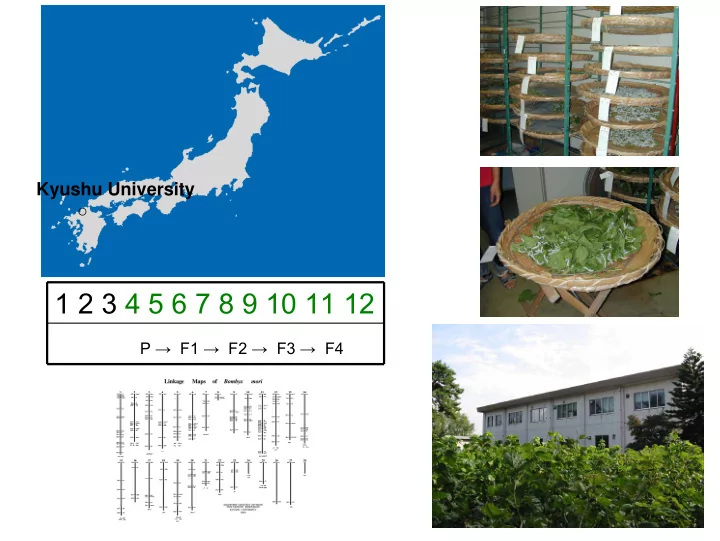

Kyushu University ○ 1 2 3 4 5 6 7 8 9 10 11 12 P → F1 → F2 → F3 → F4
National bio-resource project in Japan and development of cryopreservation methods for silkworm resources. Y. Banno, Silkworm Genetics Division, Institute of Genetical Resources, Kyushu University
National Bioresources Project (NBRP) This Project had been started at 2002 supported by the Ministry of Education, Culture, Sports, Science and Technology. Purpose 1.Collection 2.Preservation 3.Distribution for bioresources that are basic materials for life sciences research.
Participant organizations for silkworm • Kyushu University (core) Silkworm strains ( B. mori and B. mandarina ) • University of Tokyo (Sub. 1) Genome resources • Shinshu University (Sub. 2) Wild silkworms • National Institute of Agrobiological Sciences (Sub. 3) Transgenic silkworms
Available resources <Domesticated silkworm> • Mutant strains 500 • Improvement strains for artificial diet 200 • Transgenic strains 100 <Wild silkworm • Antheraea yamamai 5 • Antheraea pernyi, Samia cynthia 1 <Genome> • 220,000 clone (DNA / cDNA) from 50 libraries
Egg larva pupa (cocoon) moth
You can get eggs year-round ○ �Distribution is okay . When we use the egg laid in June*
MTA is used for distribution in NBRP . MTA :maternal transfer agreement. <Aim of MTA> � Protection of the intellectual property rights of developer of strains. → The usage of the strains is limited in only purpose agreed in MTA.
MATERIAL TRANSFER AGREEMENT (FOR DISTRIBUTION) RECIPIENT Recipient Staff: Recipient Organization:__________________________________________________ Address: This Material Transfer Agreement sets forth the terms and conditions under which Institute of Genetic Resources, Kyushu University (hereinafter referred to as ‘IGRK’) will provide with the RECIPENT, and the RECIPIENT will receive, the biological material specified as ______________________________and/or it’s derivatives (hereinafter referred to as the ‘BIOLOGICAL RESOURCE’) in response to the RECIPIENT’s request, and with which the RECIPIENT staff and organization agree before the RECIPIENT receives the BIOLOGICAL RESOURCE: The IGRK is engaged in collecting, maintaining, storing, multiplying and distributing the biological resources, in order to contribute to the Japanese and international research community for the development of the research and utilization in the field of life sciences. (a) The RECIPIENT shall use the BIOLOGICAL RESOURCE for the following specific purpose: .
Long- term preservation �frozen sperm�
1st STEP Collection of the sperm from male seminal vesicle of moths. 1)Take out the male internal reproductive system by dissections. (important tissues are glandula prostatica and seminal vesicle). 2) Soak the dissected tissues to small beaker filled with physiological solution (0.80% NaCl). Usually 30-40 individuals stoked.
3) Collect the seminal vesicle(with glandula prostatica) by forceps. Be avoid contamination of other tissues such as fat body and some tiny granules. Move the dissected seminal vesicle(with glandula prostatica) to cooled small dish.
4) Transfer one seminal vesicle(with glandula prostatica) on small cooled dish. Rupture seminal vesicle(with glandula prostatica) by forceps so that the sperm go out. Repeat this procedure until you get enough volume (65-80 μℓ ).
2nd STEP Freezing process (cryopreservation) of the sperm. 1)Add the same volume of Cell banker 2 (cryoprotectant chemical) to the collected sperm. 2) Draw up the sperm solution in a straw (detail show in Fig.). 3)Storage at -80� for 15 seconds, and keep it in -196�(liquid N2) until use.
3rd STEP Insemination 1)Thaw the frozen sperm in water bath (37�) for 5 seconds. 2) Add the trypsin solution and mix the both solutions gently.
3) Transfer 6 μℓ sperm solution into artificial penis (handmade with glass). 4) Inject the sperm to female moth by using the foot switch.
Instruments and chemicals for artificial insemination Stereoscopic microscope Clean bench (not necessary) Forceps Scissor Small dish Refrigerant N2 tank Grace’s medium Physiological solution (0.75% NaCl) DMSO(Dimethyl sulfoxide) → Adjust 10% with Grace’s medium Liquid nitrogen Trypsin → Adjust the concentration to 0.3 μ g/ml with Grace’s medium if available unit is 5000U trypsin. Semen straw 0.25ml Micro tube 50 μℓ for artificial penis Micro tube 5 μℓ for semen tranfer
Long- term preservation �use of frozen ovaries� freezing thawing Transplantation Take out of ovary at -196� in N2 tank Ovary-ectomized female
Success rate Difference betw een (Ave.) strains Wide Sperm 30% Many strain are in 0% Smaller than sperm ovary 30% To evaluate, w e need testis 10% more experiments.
Recommend
More recommend